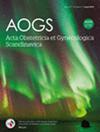Outcomes associated with fetal nuchal translucency between 3.0 and 3.4 mm in the first trimester
Abstract
Introduction
Decisions concerning nuchal translucency (NT) between 3.0 and 3.4 mm remain controversial, particularly regarding whether to first calculate the combined first trimester screening test or to proceed directly with invasive testing. The literature suggests an increased risk of chromosomal aberration, as well as pathogenic copy number variations (CNVs) on chromosomal microarray, for fetuses with NT between 3.0 and 3.4 mm. The aim of this study was to describe genetic findings of fetuses with NT between 3.0 and 3.4 mm in the first trimester. The secondary objective was to describe ultrasound findings and adverse outcomes for these fetuses. The third objective was to compare genetic, ultrasound findings and adverse outcomes of fetuses with NT between 3.0 and 3.4 mm to those with NT ≥3.5 mm.
Material and Methods
We conducted an observational, retrospective study in a referral center between 2017 and 2022. Genetic and ultrasound findings were compared between fetuses with NT between 3.0 and 3.4 mm and those with NT≥3.5 mm. An adverse outcome was defined as one of the following: miscarriage, perinatal death (stillbirth or neonatal death) or termination of pregnancy at parental request, and all major abnormalities or genetic disorders diagnosed before or after delivery.
Results
We included 404 fetuses with NT≥3.0 mm who had invasive testing with available karyotype and chromosomal microarray, among whom 20.8% (84/404) had NT between 3.0 and 3.4 mm. The rate of adverse outcomes among fetuses with NT between 3.0 and 3.4 mm was 32.1% (27/84). The rates of chromosomal aberration, pathogenic CNVs, and major ultrasound abnormalities were 16.7% (14/84), 6.0%(5/84), and 9.2% (6/65), respectively, for fetuses with NT between 3.0 and 3.4 mm. In comparison, fetuses with NT greater than 3.5 mm had higher rates of chromosomal aberration and major ultrasound abnormalities, with rates of 47.5% (152/320) and 30.2% (49/162) respectively compared to 16.7% (14/84) and 9.2% (6/65) for fetuses with NT between 3.0 and 3.4 mm (p < 0.001 for both comparisons). However, the rate of pathogenic CNVs was not significantly different between the two groups, with rates of 1.9% (6/320) for NT≥3.5 mm and 6.0% (5/84) for NT between 3.0 and 3.4 mm (p = 0.06).
Conclusions
The rate of chromosomal aberration and pathogenic CNVs on chromosomal microarray is high among fetuses with NT between 3.0 and 3.4 mm, although these rates remain lower than those observed among fetuses with NT≥3.5 mm.


 求助内容:
求助内容: 应助结果提醒方式:
应助结果提醒方式:


